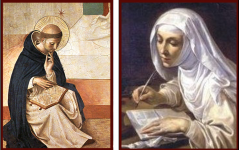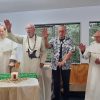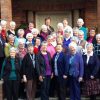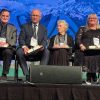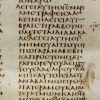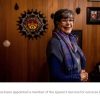 DOMINICAN LAITY
DOMINICAN LAITY
Newsletter #23
August 2012
Dear Friends
A large newsletter this time, because we have a number of international items that help give a picture of the global reach of Dominicans.
But first, a few local matters. And we begin with a most charming picture from Teschmakers
Sr Mary Horn OP with Mrs Sarah Wellwood Hughes, mother of Barbara Hughes, at the Teschmakers Centenary in March.
More local news:
We note the death in Dunedin a few weeks ago of SISTER ALBAN, who was the oldest member of the congregation. Requiescat in pace.
Sr Judith Robinson OP is now recovering from surgery in Invercargill. We are informed that Korimako Farm was in the good hands of Sr Mary Anna Baird!
Auckland Dominicans may be interested in an excellent symposium called THE WORD OF GOD which celebrates the 50th anniversary of Vatican II. It will be held in Auckland over the weekend of 12-14 October. Pat Lythe will have information. patl@cda.org.nz
Planning for the visit of Fr David Kammler OP, Promoter for the Laity, next year is proceeding well. He will visit Auckland, Palmerston North, Wellington, Oamaru, Dunedin, Invercargill and Queenstown. The Profile which Norman Gray reports on below was done in preparation for Fr David’s visit.
————————————————————————————————————————-
Profile of the Dominican Laity in Aotearoa/ New Zealand
update by Norman Gray
On behalf of the Laity Consult group, I wish to thank all of you who have responded to the survey either on the Survey Monkey web-site or by an old fashion paper survey.
We have had 56 responses to the survey, which is a FANTASTIC response rate. My heartfelt thanks. For those of you who haven’t responded and would like to, please send Norman an e-mail to nlgray@xtra.co.nz and he can send the link to the survey to complete on-line or if you prefer your mailing address and Norman will send out a paper copy to you with a returned self addressed envelope.
What have we learnt from your responses?
First are the demographics: the laity like the Sisters and Friars are aging and there are few younger people following in our footsteps. 67% (37 of us) are 60 years of age or older. 24% (13 of us) are in our 50’s and just 9% (5 people) are in their 40s. Eighty-two percent of the respondents are female and eighteen percent are male.
Ninety-four percent of us “Somewhat or strongly agree” that we Lay Dominicans have a vital role to play in the preaching mission of the Order of Preachers.
How do we preach to our world? The leading responses are:
By our good actions and how we live our lives.
Modeling Christian values in our lives.
Prayer life
Talking about Gospel values in conversations with in the home, community, and the work place.
Advocating for social justice and human rights issues.
The development opportunities that we would like to see offered to the Laity of the Dominican Family in Aotearoa/ New Zealand in order of “votes” are:
Quarterly newsletter by e-mail or post.
Information on peace and justice issues and how you can respond.
Opportunities to learn more about the Four Pillars of Dominican Life – prayer, study, community, and mission.
Regular gatherings with other Dominican Family members for study and prayer.
Yearly guided retreat
How to be a “prayerful presence” to our world.
The final question asked “How would you like the Dominican Laity to develop in Aotearoa/New Zealand. A sampling of your responses are:
With many of our members aging, I would like to see lay groups providing more opportunities for middle aged and young adults to link in with the family.
Presenting grass root concerns to the other parts of the Dominican Family so there is an awareness of needs and hopefully a response for change.
To see more of a structure to being a Dominican lay member.
Communication and enhancing the sense of community – through electronic media.
Hearing about national and international initiatives that connect with the Dominican charism.
More interaction, meetings, and developing a profile.
I think the Dominican Laity needs to be empowered to make things happen and a group needs to drive a few initiatives each year that don’t overburden them. Help those who are keen to learn.
The information you have provided will be summarized and provided to Father David Kammler for his visit to Aotearoa/ New Zealand in February and March 2013.
We the members of the Laity Consultation Group will also spend some time reviewing and discussing your responses and find a way to address your needs.
Peace and Blessings,
Norman
—————————————————————————————————–
INTERFAITH
It is always interesting to hear what Dominicans around the country are doing. Mary Eastham is a parishioner at St Brigid’s, Feilding. She is a member of the Bishops’ Committee for Interfaith Relations and chair of the Palmerston North Interfaith Group. The recent Muslim time of Ramadan was an opportunity for the Group to reach out into another faith experience. Here is Mary’s report, reprinted with thanks from Wel-com, Catholic newspaper for Wellington and Palmerston North dioceses
Ramadan its meaning and relevance
With the month of Muslim spiritual and bodily purification that is Ramadan starting late last month, the Palmerston North Interfaith Group came together on July 9 to hear Dr Ibrahim Al-Bahadly of Massey University bring greater understanding of the practice.
Ramadan is to Muslims what lent is to Catholics – a time of intense prayer, fasting and charity to purify our inner lives and renew our relationship with God (Allah in Arabic). It is the ninth month of the Islamic calendar, and began on July 20.
The fast consists of total abstinence from food and drink from dawn to dusk and gives Muslims an opportunity to cultivate the desire to turn away from sin and embrace a life of virtue.
Virtues encouraged in Muslims are familiar to Catholics and include forgiveness, gratitude, moderation and restraint, charity, courage and fortitude, concentration, willpower, self-control.
A further link with Catholicism and its social teaching is the focus on social justice that Muslims observe during Ramadan.
Individualised acts of charity on behalf of marginalised people are important, but they are mere bandaids on the open wound of poverty and unemployment – both social evils caused by economic and political policies which favour the interests of the wealthy.
Overconsumption and Starvation
The rigorous fasting expected of healthy Muslims and the fact that this discipline is joyfully accepted and scrupulously observed so as not to damage health, calls into question the current obsession in “developed” countries with food, not to mention the fallout from overindulgence.
Images of food – fast food, gourmet food, cooking programmes – dominate the media. These can often be juxtaposed with photos of malnourished men, women and children from the Third World. Such images reveal the structural nature of both overconsumption, a creature of the advertising industry, and the destitution which is the result of unsustainable development policies. Such policies based on First World economic models have not created just and egalitarian societies in the Third World. Far from it.
A Muslim brother from Pakistan remarked that abstaining from water during Ramadan always reminded him that water is sacred, because having access to fresh water meant the difference between life and death for many people.
In desert countries and countries like Pakistan with rugged mountains and vast plains, water means life and survival, as well as being cleansing and refreshing. No wonder it is a sacred symbol in so many faith traditions.
Interfaith events often facilitate extraordinary encounters among people from different cultures and faith traditions. The interfaith event at Massey University’s Te Waiora Centre brought together Muslims from Iraq, Pakistan and Sudan, Christians (Catholic, Anglican and Presbyterian) from England, Ireland, New Zealand and the USA, and oir Sikh brother Jaspreet Singh. From India.
Dr Al-Bahadly comes from the cradle of Western civilisation and the birthplace of writing and law, Iraq.
Mary Eastham
————————————————————————————————-
JOURNAL FROM FR PETER MURNANE IN THE SOLOMONS
Gizo Journal 11 August 16 2012
(Note: this and previous Gizo Journals can be read at the blog:
findingthetreasure.wordpress.com )
Your Dream House by the Lagoon?
One of our workers, Peter, was sick. He lives a few hundred metres through the bush along from our jetty, so I walked over to see how he was getting on. Life here is busy, so I don’t often enough take a leisurely walk around our own island. I was delighting in my morning expedition along the winding foot-track through the teak plantation, with coconut palms and a few mahogany trees adding their graceful beauty.
Peter’s house came in sight when I was still some distance away. It stands on stilts in a cleared, sandy area among coconut and pandanus palms and is built mainly of local materials and roofed with sago-palm leaf. His little boy was playing with a toy truck in the sand; the blue lagoon lapped on the beach almost at the front door; a battered dug-out canoe was parked at the high-tide mark. It looked like the tropical ideal that books and films have put before us for more than a century, and which has so attracted the populations of “developed” countries that men will slave for half a lifetime to try to reproduce it when they retire by the sea around the coasts of Australia or New Zealand.
Peter is a happy man, but with due respect to Plato, who most of us remember as teaching about the ideas or ideals of things, beyond and better than the world we are familiar with, this idyll has to be analysed. I found Peter lying on a hammock beneath his house – completing the ideal! – but he was sick. (Here I will disguise his personal details; what follows might apply to any island people in his position). His sickness might have been only flu, which is serious enough, but might be malaria or something worse. At once it threatens his power to earn a living by labouring or canoe driving for a modest wage, and by regularly night-diving for fish to supplement his meagre income and diet. He has a wife and children to support, but no medical insurance. The superannuation scheme in this country is small, and naturally depends on how many years one has contributed. If Peter had moved from his home in one of the poorer islands of the Solomons chain, he would be far removed from his wider family who might have supported him in old age.
My thoughts about the tropical idyll were reinforced a short while later, when we were invited to a celebration in the village of Nusabaruka, across the lagoon. This is a village of immigrants from Kiribati (Gilbert Islands) who came in the 1970s because of population pressure and lack of land. It is built on mangrove flats about a kilometre west Gizo town, but the swamp prevents any road being built. To reach it by steep bush track takes up to an hour of walking, so the main access is by canoe, but few can afford to own one. After the 2007 tsunami destroyed most buildings and killed nine children, the people moved their simple homes inland to slightly higher ground in the bush.
Families are large, and live mostly in poverty. Most of the flocks of children and teenagers do not go to school. There is a high rate of young pregnancies.
We were honoured guests at the celebration of a first birthday, which for a first-born son is important in Kiribati tradition. But as we enjoyed the food and company, my mind wandered to possibilities of providing a school, or even teachers, for the many children here who are growing up illiterate, with little English, few prospects of a job and already losing their own ancient and beautiful Kiribati culture.
While this is surely the government’s responsibility – a canoe service to take kids to school in Gizo would be a big help – I think of Mary McKillop, Catherine McAuley, Edmund Rice, John Baptist de La Salle and others who took direct action to teach needy children, and even ponder calling on Dominican Volunteers International. Perhaps these too are ideals that do not fit today’s world, but then tropical dreams have inspired a lot of people before this.
Peace to you all –
Peter
—————————————————————————————————————
DOMINICANS AROUND THE WORLD
• Introducing the International Dominican Foundation
The International Dominican Foundation (IDF) is an organization founded at the beginning of the 21st century in order to further the rapidly expanding global mission of preaching and teaching the Word of God by the Dominicans, the Order of Preachers. The organization consist of lay people, religious brothers and sisters, and priests from North America inspired by the evangelical zeal of St. Dominic to preach, bless and praise Jesus Christ in our lives and we accept our Lord’s mission to carry the gospel to the ends of the earth.
The vision of IDF is the Dominican vision, a world where the Catholic faith can be lived, believed and shared with others in freedom and in truth so that more people may come to know the good news of Jesus Christ in freedom because good news is accepted with joy not imposed by force and in truth because it is the only way to be genuinely free
Founded in 2002, the IDF is a 501 (c) (3) organization which provides crucial monetary support to Dominican educational programs in Jerusalem, Rome, Cairo and other world centers. Without this support, the teachings of Christ in these regions would be diminished. Today, the IDF continues its mission to spread the Gospel of Christ and the charism of St. Dominic through stewardship of worthy projects that meet strict cultural, educational and religious guidelines.
At its Annual Meeting held in Atlanta June 12, 2012, the IDF Board began a new phase for the organization. The Board welcomed its new Chairman, H.E. Edward Cardinal Egan, (Cardinal Emeritus of New York City) and its new President, Fr. Michael Demkovich, OP. The IDF Board is a collaborative project bringing together bishops, Dominican provincials, friars & sisters, clergy and laity, to financially support the Order’s special projects.
The Projects of IDF
The Dominican Institute of Oriental Studies (IDEO) was founded in Cairo in 1953 at the request of the Holy See to open a dialogue, without proselytism, between Muslim and Christian scholars. It is home to one of the most extensive collections of works on Arabic culture and Islam and is recognized as a preeminent research institution by international scholars. The IDEO is comprised of a team of approximately twelve scholars, mainly Dominicans. Approximately ten of the scholars live in Cairo, where they devote themselves to the IDEO’s library and welcome visitors and readers. Those who live outside of Egypt lecture in universities or work in research centers such as the CNRS in France. Some twelve other scholars are supporting them. IDEO works toward better knowledge and understanding of the Arab-Muslim cultural heritage and toward the improvement of Islamic and Christian relations. (www.ideo-cairo.org)
The Pontifical University of St. Thomas Aquinas, (Angelicum). The Angelicum is one of the principle centres for intellectual life in the Order of Preachers. A House of Studies where St. Thomas Aquinas once taught, it sought and was granted pontifical status under the mastership of Blessed Hyacinth Cormier OP. Today it offers pontifical degrees up to the level of the doctorate in theology, philosophy, canon law and the social sciences. Each year it welcomes over 1200 seminarians, religious and laypeople from almost 100 different countries. The administration and teaching staff are mainly Dominicans, supported by a 70-strong convent of friars, which makes it one of the largest communities in the Order. The Angelicum is also the accrediting body for 15 higher learning institutes spread across the world (including Blackfriars Studium in Oxford). (www.pust.it).
The Ecole Biblique and FrenchSchool of Archaeology. This world renowned centre of biblical study and archaeology produced the Jerusalem Bible and edits the Revue Biblique. Founded by the Dominican Marie-Joseph Lagrange in 1890, the Ecole continues to offer scholars of the Bible and the archaeology of the Holy Land a unique venue to study, teach and publish. There are twenty Dominican friars assigned to the Ecole and approximately forty postgraduates from different parts of the world in residence. Situated in East Jerusalem, the Ecole’s students and staff witness the inter-religious context of the modern world not as a subject of study only but as a real life experience. This sensitivity to different cultural and religious contexts has inspired the community to begin a new bible project called the Bible en ses traditions (‘BEST’). BEST will not be yet another Catholic bible, but one that can be read ‘catholically,’ that is with equal attention given to the Scriptural text and the Traditions of reception, including Jewish, Protestant and Orthodox readings. (www.ebaf.info)
As a follow-up, IDF plans regular pilgrimages to these Projects, with educational offerings by the friars and professors, updates on the status of the projects, excursions to other places of interest in the nearby areas.
To Cairo where we can visit the Institute of Oriental Studies and travel up the Nile to the ancient temple sites. At the Ecole Biblique in Jerusalem, where we can visit the holy sites and travel to Galilee and the Dead Sea to learn more about the Dead Sea Scrolls. At the Angelicum in Rome, where we can have short courses taught by world renowned instructors on the Church today, the art to be found in Rome, the Vatican museum, Santa Sabina and other wonderful Dominican sites.
IDF Associates
In June of 2008, the IDF Board under the direction of Fr. Carlos Aspiroz Costa O.P., Master of the Order, gave approval for the foundation of the IDF Associates, a select group of supporters, both lay and religious, formed to assist with Dominican projects around the world, and to help the Dominicans bring the good news of Jesus Christ to new peoples and new places.
As members, associates will be:
o Remembered always in a special way in the prayers and Masses of the Dominican friars.
o Invited to the festivities leading up to the special 800th anniversary celebrations in Rome in 2016.
o Given information about opportunities to attend annual pilgrimages visiting the IDF projects.
o Enrolled automatically for timely newsletters with reports on and photos of the IDF projects.
Golden Jubilee of Dominicans in Ivory Coast
The Vice-Province of St. Augustine in West Africa ended the Golden Jubilee of the presence of the Dominican Friars in Ivory Coast (1961-2011) on Sunday, July 22, 2012 at St. Dominic Priory in Abidjan.
The solemn closing Mass was presided over by Most Reverend Jean-Pierre KUTWAN, Metropolitan Archbishop of Abidjan (Ivory Coast) in the presence of Bro. Bruno Cadoré, Master of the Order of Preachers and his Socius for Africa, Bro. Gabriel Samba. Also present at this Mass was, Most Rev. Pierre-Marie COTY, Bishop Emeritus of Daloa (Ivory Coast), His Excellency Jeannot Ahoussou KOUADIO, Prime Minister of Ivory Coast and several other personalities.
The large Dominican Family in Ivory Coast, Christians and friends of the Brothers wearing the loincloth of the fiftieth anniversary came to celebrate together with the forty Brothers present at the Mass. Bro. Pierre Pirson one of the elders of the priory of Abidjan came from Belgium for the occasion.
Fifty years is “the age of maturity,” said Bishop Kutwan. The Archbishop of Abidjan recalled the achievements of the brothers and expressed his gratitude to them. He also paid tribute to the pioneers of Dominican presence in Ivory Coast. Finally he questioned the brothers to continue their mission in the current context of the Ivory Coast, announcing to all that “the time of joy can begin,” that “God has mercy on his people” and to be artisans of Reconciliation, Justice and Peace as Pope Benedict XVI says in Africae Munus.
In his speech for the occasion, the Master of the Order, Bro. Bruno Cadoré expressed his great joy and the gratitude of the Order for the work that has been done. He also expressed his gratitude to the first brothers who were messengers of God’s friendship in Ivory Coast. He noted that, “celebrating the Jubilee is to commemorate the history of which we are heirs” and also “to learn on our roots to build the future.” The wish of Master of the Order for this jubilee is to see the Brothers being “animated by insomnia of compassion “and being “concerned with the truth for the next 50 years “.
As part of the festivities marking the end of the celebration of the fiftieth anniversary, Most Reverend Jean-Pierre KUTWAN, Metropolitan Archbishop of Abidjan (Ivory Coast), ordained two brothers to the deaconate. They are, Bros Ambrose K. Sodokin and Aurel Hugues G. da Silva. The Mass of the ordinations took place on Saturday, July 14, 2012 at 9:00 am in St. Paul’s Cathedral in Abidjan. Let us keep our brothers in our prayers.
Fr. Gabriel Samba, OP (AFRIDOMS FLASH N°007)
• Devotion to St Mary Magdalene in the Order
St. Mary Magdalene is known as the Apostola Apostolorum—the Apostle of the Apostles—because of her role in the accounts of the events surrounding the Resurrection. As Dominicans we seek to imitate her great faith and zeal in proclaiming the Good News of the Lord. Yet, a further connection can be established that links this saint, regarded as a patroness of the Order, to the Dominican family.
In the thirteenth century, great efforts were put forth in France, Italy, and Germany to convert women who led sinful lives. When such conversions were made, bishops grouped these women together into communities who took St. Mary Magdalene as their patroness. In Germany, these communities of women were given the Constitutions of the Dominican Nuns and incorporated into the Dominican Order.
In 1286, Charles II turned the Dominican Order toward devotion to St. Mary Magdalene. In 1297, the feast of St. Mary Magdalene was celebrated with solemnity throughout the Order, as the General Chapter of Bologna had recommended.
Why Mary Magdalene? Dominicans strive to be apostles, preaching the gospel of Christ, and so draw their inspiration from she who was so closely associated with Christ and the early history of the Order. Further, it seems that St. Mary Magdalene, in tradition and in literature, is constantly endowed with three characteristics: she is the converted sinner, she is the contemplative soul and she is the herald of the Resurrection. These characteristics powerfully describe the preaching office and thus our Dominican life. How can one speak of the mercy of God if one has not experienced it oneself? How can one speak of God without speaking with God?
The life of St. Mary Magdalene as portrayed in the four Gospels serves as a model and a reminder not only for Dominicans, but also for all Christians, that to be fruitful apostles we must first be faithful disciples. In order to hear the call of Christ and follow it unreservedly, we must undergo a conversion of heart. As a sinner-turned-saint, Mary Magdalene’s life testifies that allowing the reality of our sinfulness to keep us from our vocation to follow Christ is a mistake. We see in this woman that Jesus calls, that Jesus heals, that Jesus brings the true freedom which enables her to embrace her vocation to holiness. We are inspired to embrace Him in that same freedom.
The interior freedom won for us by Christ leads to the freedom of self-giving. St. Luke counts Mary Magdalene among those who provided for Jesus out of her means (cf. Luke 8:3). St. Mary Magdalene shows us that the only proper response to the limitless love of Christ is to love without limit in return. She places every gift at the service of Christ and His Kingdom, returning love for love.
• Dominican Mysticism from Caleruega
Dear Sisters and Brothers, with this report I would like to share with you the experiences we had in Spain from the 23rd to 27th of June 2012 on the course about Dominican Mystics. The course was organized by the Promoter of the Nuns – Fr. Brian J. Pierce, OP with the three Federations of Nuns in Spain. It was open to participants from all the monasteries of Spain. The venue that was chosen to celebrate this course was Caleruega, the birthplace of our father Dominic. The course was given by fr. Brian J. Pierce and Sr Silvia Bara Bancel, OP, sister of the Roman Congregation of St Dominic, who is specialized in Rhine Mysticism.
The participants arrived on the 23rd afternoon. We were 75 sisters from different monasteries of the three Spanish federations. I must mention the presence of the Common Novitiate of the Federation of Our Lady of the Rosary and some sisters from Chile who belong to the Federation of the Immaculate. They had come to Spain to participate in the Federal Elective Assembly which was held between May and June.
The course consisted of two talks in the morning and two talks in the afternoon, interspersed with group works and breaks. There were two important moments for prayer were; in the morning with the celebration of the Eucharist and Lauds and in the afternoon with Vespers and private prayer with the adoration of the Blessed Sacrament. This timetable did not permit us to get bored at all.
Thanks to the path taken, the experience is of great joy and richness for all because of the time we were able to share. For this reason the group works and moments of fraternal sharing created a communion among us all. In the groups we talked about different topics; the situation of the monasteries, the experiences of vocations and we commented on the texts about the Dominican Mystics that had been prepared in a notebook by the Federal Prioress of the Federation of the Immaculate.
During the course we lived different experiences. The novices added charm to the recreation with different dances, guitars and African drums. The sisters of the Roman Congregation of St. Dominic, who were having a formation course at that time, joined us in one of the recreations. We also had a moment of intense prayer at the well of St. Dominic with Dominican songs and of course we drank some water from the well. We made a procession to the Parish of St. Dominic where fr. Basilio, OP, the parish priest of Caleruega, encouraged us to live the grace of our baptism. We enjoyed listening to the faithful of Caleruega singing songs about our father St. Dominic. At the end of the course we visited the monastery of Lerma and the sisters welcomed us with snacks. We lived a special moment listening to the music of “The Mission”, etc…
The experiences were sources of abundant graces which encouraged us to go on with our mission of the “Holy Preaching”. At the end, we wish the experiences would enable us to deepen ourselves in the charisma of our Order, our knowledge of Dominican mysticism and also sustain us along this path. Thanks to all those who made this possible.
-A participant
• Nigerian OP Sisters On Collaborative Initiatives
The three Dominican Sisters Congregations in Nigeria came together for a seminar/workshop on collaborative initiatives. The theme of the seminar/workshop was “Development Grounded in Legacy and Charism” and it was held at the Dominican Sisters Novitiate House at Markurdi, in Northern Nigeria. The program was organized by the sisters who attended the training session in Lusaka in August 2011. It lasted for four days. About 32 sisters of Perpetual vows participated in the program.
The topic was on Catholic Social Teaching. A power point presentation on the Documents and Major Theme of the Catholic social teaching was delivered by Sr. Paulina Chioma Ogbonnaya, OP who was the coordinator of the programme and also the Promoter of Justice and Peace for Dominican Sisters Africa (DSA). There was also group work, group sharing and presentation of each group work to the general assembly. We examined ourselves as Dominican Sisters in Nigeria critically and allowed ourselves to be challenged by the social teaching of the Church especially on just wages, unjust treatments of women and children in our country. We, as Dominican Women in Nigeria are called to ‘See, Judge and Act’.
The sisters also had a field experience to a settlement in Makurdi, Benue State Nigeria, where on Easter Vigil Mass, rain storm pulled down part of the building killing 22 persons and injured many. Those who died were all buried in the mission compound, one beside the other. It made a deep impression on us seeing 22 fresh graves! It was a very pathetic sight! We prayed and condoled with the priest assigned to that mission and with the people of the settlement. The celebration of ourselves as Dominican Women in Nigeria, took a lot of the last evening. We were very happy coming together to discuss and celebrate our oneness, our common and glorious heritage –‘The Dominican Spirituality’. We felt good and demonstrated this through dances, drama presentations and of course delicious meal.
In our evaluation of the whole program, all the sisters who participated expressed satisfaction and their great joy seeing the three congregations in Nigeria coming together to deliberate on a common purpose. The desire to work out more ways of collaboration among the Dominican Sisters in Nigeria was very strong and very much emphasized by all.
We use the medium to say a very big thank-you to Srs. Faustina Jimoh, O.P and Margaret Hussain, O.P for supporting the program both financially and otherwise. We thank the Prior Provincial of Dominican Fathers and Brothers, Nigeria and Ghana, Very Rev. Fr. Charles Ukwe, O.P, whose brief presence was an encouragement to us all.
Our next Seminar/Workshop on Development Grounded in Legacy and Charism will be organized for the Temporary professed sisters of the Dominican Sisters Congregations in Nigeria in the coming year 2013. The Planning committee will work towards that and give details with time.
Ours is a Development grounded in Legacy and Charism and we are committed to it. For … BY HUMAN DEVELOPMENT WE MEAN ALL THOSE THINGS THAT ENABLE HUMAN BEINGS TO LIVE MEANINGFUL, HEALTHY AND WHOLE LIVES… FOR ANOTHER NAME FOR PEACE IS DEVELOPMENT!
Srs Caroline Igwe, OP, Patricia Daaor, OP, Cecilia Madu, OP and Sylvia Ibida, OP – Planning Committee.
• A Common Study Programme at Bangkok
The fourth Common Study Programme for the solemnly professed and the newly ordained Dominicans of Asia-Pacific Region was held at Baan Phu Waan, the Pastoral Center of the Archdiocese of Bangkok from the 17th of June to the 14th of July 2012. The theme of the programme was “Mission as Dialogue”: which is, dialogue with self; dialogue with the poor, dialogue with other religions and dialogue with the World.
There were sixteen participants from eight different countries of Asia Pacific. The host of the programme was Fr Joseph Ngo Si Dinh, OP, the Provincial of the Province of Vietnam. He delegated the task to Fr Joseph Nghi Dinh, OP, the local coordinator and organizer. He welcomed us and took very good care of us.
The four week programme was planned and coordinated by Fr. Vincent Lu Ha, OP (Socius for Asia Pacific Region). His concern and interest is immense and he journeyed with us throughout the programme. The programme had two student masters, Fr. Amirtha Raj, OP for the first two weeks and Fr. Edmund Nantes, OP for the last two weeks. The resource persons for the programme included; Fr. Prakash Lohale, OP (Socius to the Master for Apostolic Life) who showed his keen interest in the mission of the Order and the need to establish the Order in different parts of the world, Fr. Joseph Nghi Dinh, OP, Fr. Edmund Nantes, OP, Fr. Amirtha Raj, OP, Dr. Yusuf Imtiaz and a few others.
The aims of the programme are;
1) To give opportunity to the young Dominicans to be in touch with the Dominicans in different parts of the world.
2) To guiding them to live in inter-cultural and inter-national communities.
3) To be a launching pad for the young Dominicans to begin their priestly life with hope and expectations
4) To build up the ability to know oneself and others.
5) To know the missions of the Order and to build up willingness to be part of it.
6) To build up skills in inter-faith dialogue.
7) To relive the four Priorities of the Order.
8) Dominican Preaching.
9) Challenges of present day life of a religious.
10) To be rooted in the Church and also be relevant in the modern world.
The expectations placed on the students were high and demanding. However, the involvements and activities kept the programme alive and vibrant.
The liturgy, classes, sports, recreation, visitation to different places kept all the participants together and interested in one another and in all that was happening. It was also a rare opportunity for us to participate in the inauguration of the ‘First House’ of the Dominicans of the Province of Vietnam. One of the highlights of the programme was living in the Buddhist Monastery ‘Chang Wat Petchabun’ for four days and spending the time learning the art of Buddhist meditation and living and sharing the Buddhist monastic life. This is an experience cherished by the participants.
Fr. Amirtha Raj, OP
• Racine Dominican Sisters’ EcologyCenter for Justice
Located off 6 Mile Road in Racine, Wisconsin, lies a unique destination. It is home to the Racine Dominican Sisters’ Ecology Center for Justice. The “Eco-J Center,” as it is called by those who know it as home, is a center for education, conservation, and sustainability. These values sprout from the 8 Rs, which are the roots of this great foundation: Reuse, Reduce, Recycle, Reverence, Respect, Responsibility, Rethink, and Repair. Not only do they instill in those who visit the awareness of personal responsibility but also compel them to action.
Throughout the year, the Eco-J Center hosts a variety of events and summer camps to bring awareness to these 8 Rs. During the year students from a plethora of schools in the area visit the Ecology Center to learn of its unique position in our community. Groups as large as 90 students have traversed the serene landscape, listening, learning and absorbing the unique way of life the sisters sustain. In the summer, however, the Eco-J Center is home to youthful and energetic children attending the various camps offered. Camps go week-by-week in accordance with age, hosting groups from the ages of 6-11 year olds, as well as 12-14 year olds. Youth volunteers also join in the summer activities at the Eco-J Center through summer work programs. These young adults ranging from the ages of 13-18 participate in the upkeep and growth of the center while living and learning by the 8 Rs.
The younger campers partake in many activities throughout their week including crafts, chores, and caring for the diverse animal population. The crafts created scale with the age of the group attending. Some crafts for the older groups include creating pouches and necklaces from alpaca fur. The campers venture through the process of carding and felting the hair from the alpacas, which live on the farm, to create their projects. One veteran camper gleefully exclaimed, during the first week of camp, how many of her friends and family comment on her alpaca fur necklace. “Lots of my family and friends ask me what it is and where I got it” Clara said. This allows her to begin an exciting conversation about how she was able to make this jewelry all by herself from the fur of an alpaca at the Eco-Justice Center.
During the first of this summer’s three camps, the older campers also indulged in the opportunity to create items such as seed starters, learned how to use clay from the Earth to create pottery, and even created water containers by carving out gourds. Sister Janet, the head of the center, explained how important gourds were back before glass and plastic bottles. “Gourds were used for a variety of tasks including transporting water, drinking liquids, as well as for soup bowls. The campers learn how simple things in nature can be used for many tasks.”
Not only do the students gain knowledge of nature and values from the 8 Rs, the Eco-J Center provides a healthy and exciting environment for children of all ages to grow in friendship with other campers. Some of the camps for older kids host participants who have been in the program since its birth. After three or more years, campers really get to know each other, and friendships grow beyond the center. The veterans commented how they enjoy returning every year, always expecting a handful of the same kids, but also looking forward to meeting new people and growing together. As one camp assistant, Nancy, said: “I love coming to help out each year, not only to assist the sisters but to see the growth of the campers and the magical experiences they encounter.” During the camp the children are encouraged to learn and appreciate the 8 Rs. Being effective at recycling and reducing waste are key rules, however the kids are challenged to go beyond just the physical tasks and really keep in mind the attitude and responsibilities they hold for the future of their Earth. Sister Janet shared, “These young campers play a critical role in the cycle of this Earth; we try to teach them how each of us has our own little spot on this Earth and how important it is to do our part.” A prime example of this is depicted through one veteran camper, Nolan, who boasted, “I’ve been using this same cup for the past 5 years of camp!”
Another one of the veteran campers during the last week of June commented on how she really took these camps to heart and how she enjoyed hearing the truth for once about how to take care of the environment. “I enjoy these camps because I learn what’s really going on to my Earth and how I can learn to take care of it. We don’t learn this stuff at school, and the news isn’t always the best place to find the perspective the sisters share with us here,” Aysia said.
So whether it be Sun-day, Water-day, or Soil-day, the Eco-Justice Center is always open for children, youth, and even adults to come learn about the 8 Rs and grow closer to nature themselves and those around them through community, contemplation and sustainability.
———————————————————————————————————————
Thursday 23 August is the feast days of St Rose of Lima, a lay Dominican – and, unusually, a saint from the southern hemisphere. Let us celebrate!
Virgin, born at Lima, Peru 20 April, 1586; died there the 24 of August, 1617.St. Rose of Lima is the patroness of Latin America and the Philippines. This South American Saint’s real name was Isabel, but she was such a beautiful baby that she was called Rose, and that name remained. As she grew older, she became more and more beautiful, and one day, her mother put a wreath of flowers on her head to show off her loveliness to friends. But Rose had no desire to be admired, for her heart had been given to Jesus. So she put a long pin into that wreath and it pierced her so deeply, that she had a hard time getting the wreath off afterward. Another time she became afraid that her beauty might be a temptation to someone, since people could not take their eyes off her. Therefore, she rubbed her face with pepper until it was all red and blistered.
St. Rose worked hard to support her poor parents and she humbly obeyed them, except when they tried to get her to marry. That she would not do. Her love of Jesus was so great that when she talked about Him, her face glowed and her eyes sparkled.
Rose had many temptations from the devil, and there were also many times when she had to suffer a feeling of terrible loneliness and sadness, for God seemed far away. Yet she cheerfully offered all these troubles to Him. In fact, in her last long, painful sickness, this heroic young woman use to pray: “Lord, increase my sufferings, and with them increase Your love in my heart.” Many miracles followed her death. She was beatified by Clement IX, in 1667, and canonized in 1671 by Clement X, the first American to be so honoured. Her feast is celebrated 23 of August. She is represented wearing a crown of roses.
St. Rose of Lima is the patroness of Latin America and the Philippines. This South American Saint’s real name was Isabel, but she was such a beautiful baby that she was called Rose, and that name remained. As she grew older, she became more and more beautiful, and one day, her mother put a wreath of flowers on her head to show off her loveliness to friends. But Rose had no desire to be admired, for her heart had been given to Jesus. So she put a long pin into that wreath and it pierced her so deeply, that she had a hard time getting the wreath off afterward. Another time she became afraid that her beauty might be a temptation to someone, since people could not take their eyes off her. Therefore, she rubbed her face with pepper until it was all red and blistered.
St. Rose worked hard to support her poor parents and she humbly obeyed them, except when they tried to get her to marry. That she would not do. Her love of Jesus was so great that when she talked about Him, her face glowed and her eyes sparkled.
Rose had many temptations from the devil, and there were also many times when she had to suffer a feeling of terrible loneliness and sadness, for God seemed far away. Yet she cheerfully offered all these troubles to Him. In fact, in her last long, painful sickness, this heroic young woman use to pray: “Lord, increase my sufferings, and with them increase Your love in my heart.” Many miracles followed her death. She was beatified by Clement IX, in 1667, and canonized in 1671 by Clement X, the first American to be so honoured. Her feast is celebrated 23 of August. She is represented wearing a crown of roses.
Mike Kelly and Jenny Wilson
Co-ordinators
Ph 06 370 2084 Email: kelly.wilson@ihug.co.nz
